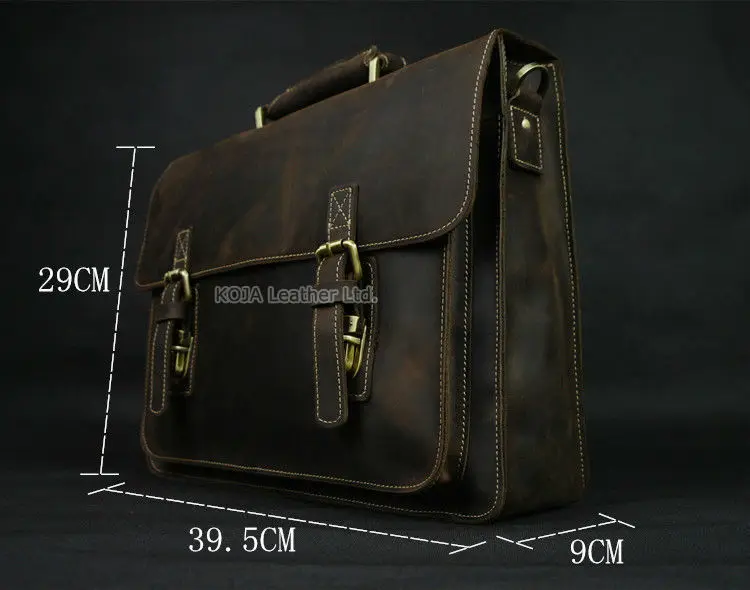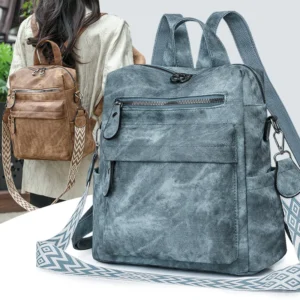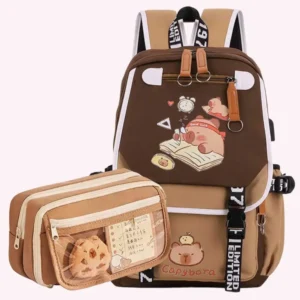Introduction: The Foundation of a Quality Leather Bag
When it comes to leather bags, not all are created equal. The difference between an exceptional leather bag and an ordinary one lies in three fundamental elements: durability, craftsmanship, and perhaps most importantly, the quality of materials used. Of all these factors, leather selection stands as the cornerstone that determines whether a bag will last decades or deteriorate within months.
The leather you choose directly impacts how your bag ages, functions, and maintains its appearance over time. A high-quality leather bag doesn’t just survive daily use—it tells a story, developing character and a unique patina that makes it more beautiful with age. In contrast, inferior leather can crack, peel, and deteriorate rapidly, regardless of how well it’s constructed.
Understanding the nuances of full-grain versus top-grain leather provides the foundation for making informed decisions when investing in a quality bag. The right leather transforms a simple accessory into a lifelong companion that serves both practical and aesthetic purposes.
In this comprehensive guide, we’ll explore everything you need to know about leather selection—from understanding different grades and their characteristics to recognizing quality indicators and maintenance requirements. By the end, you’ll be equipped with the knowledge to identify exceptional leather and make investment decisions that will serve you for years to come.
Understanding Leather Grades: The Quality Hierarchy
The grading system for leather isn’t just marketing jargon—it reflects genuine differences in quality based on which part of the animal hide is used and how it’s processed. This hierarchy directly correlates to durability, appearance, and performance characteristics that impact the final product’s quality and lifespan.
The system primarily reflects how much of the original hide structure remains intact after processing. Higher grades preserve more of the natural characteristics and strength of the hide, while lower grades undergo more intensive processing that can compromise structural integrity.
Understanding this hierarchy explains why certain leather goods command premium prices and why others might be surprisingly affordable despite being labeled as “genuine leather.”
Each grade offers different performance expectations and aesthetic qualities. When examining what 4 grades leather products typically fall into, we find that the differences extend far beyond price point—they fundamentally determine how a bag will perform throughout its lifetime.
Full-Grain Leather: The Gold Standard
Full-grain leather represents the pinnacle of leather quality, using the outermost layer of the hide with its natural surface completely intact. This grade undergoes minimal processing, preserving the hide’s natural strength and unique characteristics.
What makes full-grain leather exceptional:
- Contains the entire grain layer with its natural fiber strength
- Features visible natural markings, texture variations, and character
- Possesses the highest tensile strength of all leather types
- Develops a rich, attractive patina over time that enhances its appearance
- Remains breathable due to its intact pore structure
- Offers superior moisture resistance while allowing natural humidity regulation
The natural markings visible in full-grain leather—like subtle scars, wrinkles, and grain variations—aren’t flaws but authenticity markers. Each piece tells the story of the animal’s life, making every full-grain leather backpack unique.
While full-grain leather requires more maintenance than heavily processed options, it rewards this care with unparalleled longevity. It’s particularly ideal for daily-use bags, travel pieces, and heirloom-quality items meant to last for decades. The natural oils in full-grain leather allow it to remain supple and resist cracking when properly maintained.
Top-Grain Leather: The Practical Compromise
Top-grain leather represents the second-highest quality grade, created by sanding down the outermost layer of the hide to remove imperfections before applying a finishing coat. This process removes some of the natural character but creates a more uniform appearance.
Unlike full-grain leather, top-grain undergoes surface refinishing that gives it a more consistent look with fewer natural markings. This processing makes it thinner and less durable than full-grain, but still substantially stronger than lower grades.
Top-grain leather offers several advantages for bag manufacturing. Its smoother surface takes color more consistently, allowing for more vibrant and uniform dyes. The finishing process also provides enhanced stain resistance, making it more practical for everyday use in varied conditions.
The compromise comes in breathability and patina development. The finishing coat restricts the leather’s natural porosity, limiting its ability to develop the rich character that makes full-grain so distinctive over time. However, for many consumers, this trade-off is acceptable given top-grain’s more accessible price point and still-excellent durability compared to lower grades.
Genuine Leather: Understanding the Marketing Term
Despite what the name suggests, “genuine leather” isn’t an endorsement of quality but rather a specific grade designation—and a somewhat misleading one at that. This classification sits third in the leather quality hierarchy, representing a significant step down from full-grain and top-grain options.
Genuine leather comes from the split layers beneath the top portion of the hide. After removing the top and sometimes middle layers for higher-grade products, manufacturers process these lower sections into genuine leather goods. This material lacks the natural grain and fiber strength of the upper layers.
Typical characteristics include:
- A more processed feel and appearance
- Limited breathability compared to higher grades
- Shorter lifespan, typically showing wear within 1-5 years
- Often treated with heavier dyes and finishes to mask natural imperfections
- Prone to surface peeling as the applied finish wears off
When shopping, be wary of products that prominently advertise themselves as “100% leather” or “real leather” without specifying the grade. These terms technically include all leather categories regardless of quality, from the finest full-grain to the most basic genuine leather.
While genuine leather has legitimate uses in more affordable accessories and items that don’t face heavy wear, it’s generally not ideal for premium bags intended for daily use or long-term investment.
Bonded Leather: When to Avoid It for Bags
At the bottom of the leather quality hierarchy sits bonded leather—a material that stretches the definition of “leather” to its limits. Rather than being a natural cut from an animal hide, bonded leather consists of leather scraps and fibers mixed with adhesives and formed into sheets.
This construction process is more akin to how paper is made than traditional leatherworking. Manufacturers take leather remnants, grind them into a pulp, mix them with binding agents, and apply a polyurethane coating to create a leather-like material.
The primary problems with bonded leather in bags include:
- Extremely limited durability, often beginning to crack and peel within months
- No natural breathability or moisture regulation
- Inability to develop patina or character with age
- Typically fails at stress points like handles and seams
- Often has a chemical smell rather than leather’s natural aroma
While bonded leather has some limited applications in bookbinding or decorative items, it’s generally unsuitable for any bag meant to last beyond a season or two. The repair costs often exceed the initial purchase price when bonded leather inevitably fails.
For quality bags, bonded leather should be avoided entirely. The marginal cost savings compared to genuine leather don’t justify the dramatic reduction in lifespan and performance.
Leather Grade Comparison Table
| Grade | Durability | Patina Development | Breathability | Avg. Lifespan | Best For | Maintenance Needs |
|---|---|---|---|---|---|---|
| Full-Grain | ★★★★★ | Excellent | Excellent | 10-30+ years | Investment pieces, everyday bags, travel items | Moderate: Regular conditioning |
| Top-Grain | ★★★★☆ | Good | Good | 5-15 years | Professional bags, everyday use, fashion-forward designs | Low-Moderate: Occasional conditioning |
| Genuine | ★★★☆☆ | Limited | Fair | 1-5 years | Light-use bags, fashion accessories, budget options | Low: Basic cleaning |
| Bonded | ★☆☆☆☆ | None | Poor | <1-2 years | Temporary use, disposable items | High: Prone to damage with limited repair options |
Beyond Grade: Critical Leather Quality Factors
While the grading system provides a useful framework for understanding leather quality, it’s only the beginning of the story. Two full-grain leather bags can differ dramatically in quality depending on several crucial factors beyond their grade classification.
To truly evaluate leather quality for bags, we need to consider the complete picture: the animal the hide came from, how it was tanned, and what finishing treatments were applied. These elements interact with the leather grade to determine the final product’s performance, appearance, and longevity.
Understanding these additional leather types for durable bags helps explain why seemingly similar products can vary widely in price and quality. These factors also explain why certain leathers excel in specific applications while performing poorly in others.
Animal Origin: How Different Hides Affect Bag Performance
The animal source of leather significantly impacts its characteristics, making certain types better suited for specific bag styles and uses. Each animal hide brings unique properties that influence strength, texture, flexibility, and weight.
Cowhide serves as the standard for most quality leather bags due to its ideal balance of properties. It offers excellent durability with medium to heavy weight, making it perfect for everyday bags and travel pieces. The natural grain varies across different parts of the hide, with tighter patterns on the spine and more relaxed patterns on the sides. These variations give cowhide bags subtle character that develops over time.
Goatskin provides exceptional strength despite its lighter weight. The distinctive pebbled grain pattern occurs naturally rather than through embossing, offering built-in scratch resistance. Goatskin’s suppleness makes it ideal for bags that require flexibility while maintaining structural integrity. The natural lanolin content also provides some inherent water resistance.
Lambskin delivers unmatched softness and a luxurious feel, though with significantly less durability than cow or goat. Its delicate nature makes it better suited for special occasion bags or lined compartments rather than high-wear applications. Lambskin requires more careful handling and maintenance but rewards this attention with a buttery-soft texture that other leathers can’t match.
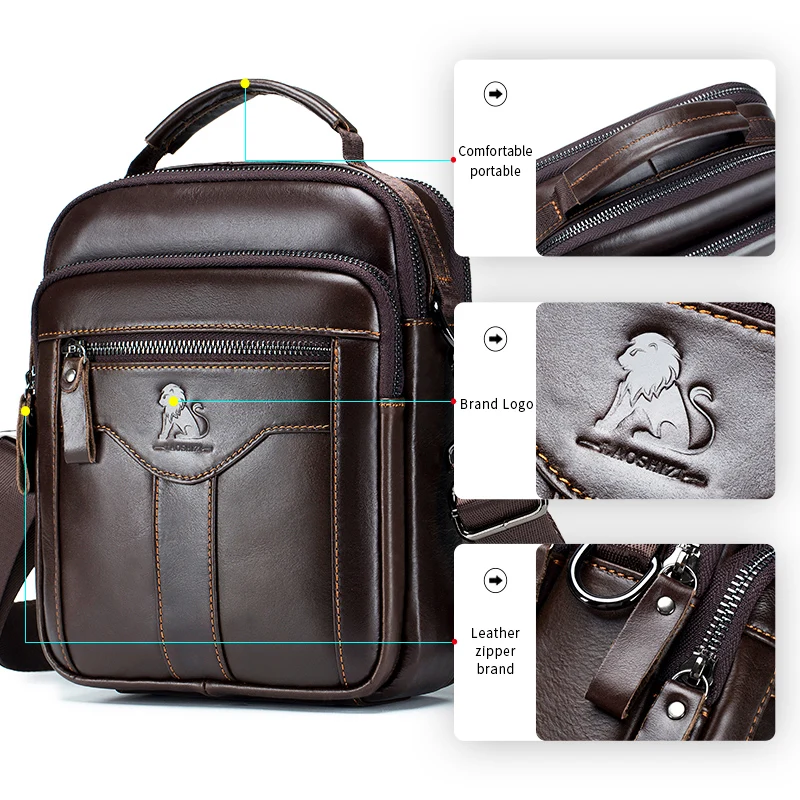
Buffalo/Bison leather offers exceptional thickness and durability, often with a more pronounced grain pattern than cowhide. Its rugged character makes it ideal for bags meant to withstand harsh conditions, though it typically weighs more than other options.
When selecting a leather bag, consider how the animal origin aligns with your intended use. A delicate lambskin briefcase might not withstand daily commuting, while a heavy buffalo leather backpack could be unnecessarily bulky for occasional use.
Tanning Methods: The Chemical Foundation of Leather Quality
Tanning transforms raw animal hide into durable leather through chemical processes that prevent decomposition and establish fundamental characteristics. The tanning method chosen significantly influences the leather’s appearance, feel, durability, and aging properties.
Vegetable tanning uses organic materials derived from tree bark and plant matter, creating leather with distinctive characteristics:
* Develops a rich patina that deepens with age and exposure
* Initially firm but becomes more supple over time
* Maintains natural scents and breathability
* Environmentally friendlier but more time-intensive
* Generally produces warmer, earthier color tones
* Ages beautifully but can be more susceptible to water staining
The art of patina development in full-grain leather is particularly pronounced with vegetable-tanned hides, which respond dramatically to sunlight, handling, and environmental exposure. This makes veg-tanned leather ideal for bags meant to become more personalized and character-rich over time.
Chrome tanning uses chromium salts in a faster, more industrialized process that produces leather with different properties:
* More consistent coloration and texture
* Greater water and stain resistance
* Softer and more pliable from the beginning
* Wider range of vibrant color possibilities
* Less dramatic patina development
* More uniform appearance between pieces
Chrome-tanned leather often serves well in bags designed for all-weather use or those requiring exceptional softness from the outset. The process allows for thinner, more flexible leather that maintains strength, making it suitable for complex designs with numerous folds and seams.
Some premium leathers undergo combination tanning, which uses both methods sequentially to achieve a balance of properties. This approach aims to capture the patina development of vegetable tanning with the softness and water resistance of chrome tanning.
Finishes and Treatments: The Final Touch of Quality
The finishing process represents the final stage in leather preparation, significantly influencing both aesthetics and performance. Different finishes create distinct looks and tactile experiences while also determining how the leather responds to use and environmental factors.
Aniline leather undergoes minimal processing after tanning, with only transparent dyes that preserve the natural surface characteristics. This finish:
* Shows all natural markings and grain variations
* Develops the most pronounced patina
* Offers unmatched breathability and comfort
* Requires more careful maintenance
* Represents the most natural and premium option
Semi-aniline leather receives a light protective coating atop transparent dyes, striking a balance between natural appearance and durability:
* Retains visible natural grain while hiding minor blemishes
* Offers improved stain and water resistance
* Develops moderate patina over time
* Requires less maintenance than full aniline leather
* Presents an excellent compromise for everyday luxury bags
Pigmented leather features opaque color coatings that completely cover the surface, creating:
* Maximum uniformity in color and texture
* Superior stain and scratch resistance
* Minimal patina development
* Easier maintenance requirements
* Good durability for harsh conditions
Specialized texture treatments like Saffiano (cross-hatched pattern) or pebbled finishes provide practical benefits beyond aesthetics. These embossed textures help disguise scratches and wear while adding distinctive character to luxury leather backpacks and professional bags.
Each finish type offers different advantages depending on the bag’s intended use. A weekend travel bag might benefit from the durability of a pigmented finish, while a heritage briefcase might showcase the developing character of aniline leather.
Identifying Quality Leather: A Practical Field Guide
Armed with knowledge about grades, animal origins, and processing methods, you can now develop practical skills for evaluating leather quality firsthand. The following sensory assessment techniques help you identify superior leather regardless of marketing claims or price points.
The “smell test” provides immediate insight into leather quality. Genuine high-quality leather has a distinct natural aroma—warm, slightly sweet, and organic. Chemical odors, strong perfumes, or plastic-like smells often indicate heavily processed or synthetic materials. The more natural and subtle the scent, the more likely you’ve found quality leather.
The “touch test” reveals equally important information. Quality leather feels warm to the touch, not cold like synthetic materials. It should have a supple quality that responds to pressure but returns to shape. Run your fingers across the surface—natural leather has subtle texture variations rather than perfectly uniform patterns.
Visual inspection offers additional clues. Look for:
* Natural variations in color and texture across the surface
* Visible pores in full-grain options (may require magnification)
* Irregular grain patterns rather than perfectly uniform textures
* Cut edges that show consistent material throughout (not layers of different materials)
* Minor natural marks that indicate minimal processing
The “water drop test,” though not always practical in retail settings, provides definitive evidence of quality. Place a small water droplet on an inconspicuous area—quality leather temporarily absorbs moisture then dries without permanent marking, while heavily coated or synthetic materials cause water to bead on the surface indefinitely.
When shopping online, where DIY leather care knowledge also proves valuable for assessment, look for:
* Detailed close-up photos showing natural grain
* Transparent information about specific leather grade and tanning method
* Evidence of patina development in product examples
* Clear policies about material authenticity
* Specific technical details rather than vague quality claims
Be wary of descriptions that use terms like “genuine leather” without specifying grade, or that emphasize “real leather” without providing details about origin or processing. Quality leather producers typically highlight their specific materials with pride and precision.
Beyond Leather: Evaluating Complete Bag Quality
While superior leather forms the foundation of an exceptional bag, several other components contribute significantly to overall quality and longevity. Even the finest leather won’t compensate for inferior construction elements that fail prematurely.
Hardware quality serves as a key indicator of overall craftsmanship. Look for:
* Solid brass, stainless steel, or other non-corroding metals
* Substantial weight that indicates solid (not hollow) construction
* Smooth operation of zippers, clasps, and buckles
* Secure attachment methods with reinforced stitching
* Consistent finishing without rough edges or plating defects
Stitching reveals much about a bag’s construction quality. Examine for:
* Even, tight stitches with consistent spacing
* Reinforcement at stress points and corners
* Thread that matches or complements the leather color
* No loose threads or irregular stitching patterns
* Backstitching or bar tacks at areas of high tension
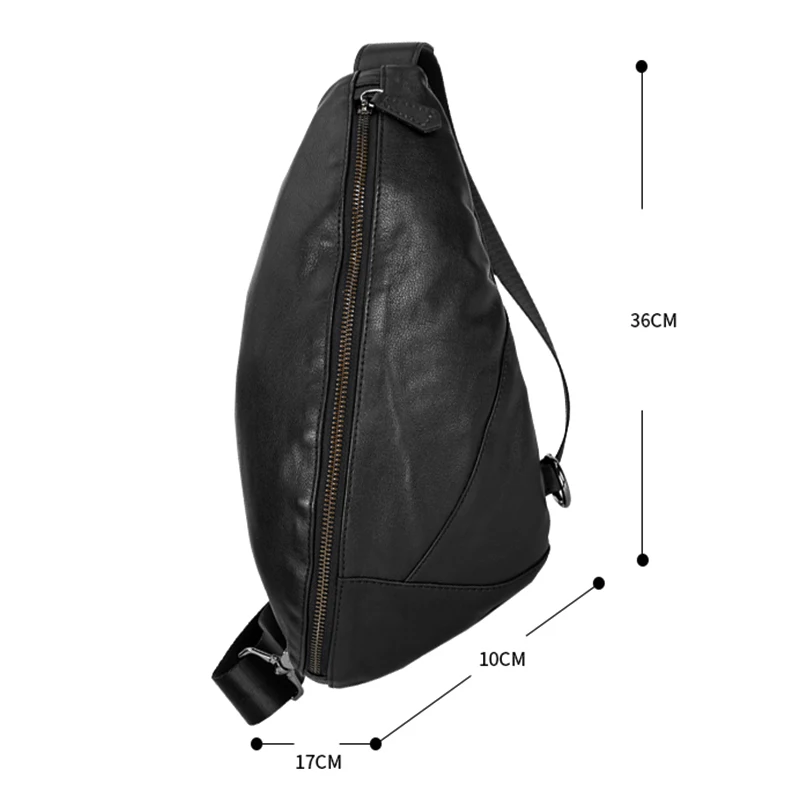
Interior construction often separates truly premium bags from mere lookalikes. Quality leather backpacks guide resources emphasize the importance of:
* Sturdy lining materials that resist tearing
* Thoughtfully designed organizational features
* Cleanly finished interior seams
* Reinforced attachment points for straps
* Balanced weight distribution when loaded
Edge finishing represents another hallmark of quality craftsmanship. Superior bags feature edges that are:
* Carefully burnished to a smooth finish
* Evenly dyed to match or complement the leather
* Free from rough spots or unfinished areas
* Slightly rounded rather than sharp
* Sealed to prevent moisture penetration
Remember that quality extends beyond visual elements—a truly exceptional bag feels substantial and well-balanced when held, with hardware that operates smoothly and a structure that maintains its shape when empty.
14 Inch Leather Laptop Backpack, Brown Leather Backpack, Men's Leather Backpack, Vintage Leather Backpack
Price range: $177.28 through $199.12 Select options This product has multiple variants. The options may be chosen on the product pageCarry On Leather Backpack, Roll Top Leather Backpack
Price range: $77.76 through $96.48 Select options This product has multiple variants. The options may be chosen on the product pageDesigner Mini Backpack, Mini Leather Backpack, Small Leather Sling Backpack, Women's Leather Backpack
Price range: $95.76 through $98.80 Select options This product has multiple variants. The options may be chosen on the product pageDesigner Mini Backpack, Designer Women's Backpack, Mini Leather Backpack, Women's Leather Backpack
Price range: $135.92 through $137.64 Select options This product has multiple variants. The options may be chosen on the product pageBlack Leather Backpack, Small Leather Backpack, Women's Leather Backpack
Price range: $112.96 through $116.12 Select options This product has multiple variants. The options may be chosen on the product page- Price range: $80.72 through $108.04 Select options This product has multiple variants. The options may be chosen on the product page
Maintaining Your Leather Bag: Protection and Preservation
Proper maintenance transforms a quality leather bag from a temporary possession into a lasting companion. With appropriate care, premium leather improves with age while inferior leather deteriorates regardless of maintenance efforts.
Basic leather care follows four essential principles:
Clean regularly using appropriate products. For most quality leathers, a slightly damp cloth for regular dusting and specialized leather cleaner for occasional deep cleaning works best. Avoid household soaps, which can strip natural oils and damage finishes.
Condition periodically to replenish moisture and maintain suppleness. Quality leather conditioner prevents drying and cracking while enhancing the leather’s natural properties. Apply sparingly—over-conditioning can saturate leather and attract dirt.
Protect proactively against environmental threats. Consider leather-specific water and stain repellents for bags that face frequent exposure to the elements. Store leather backpacks away from direct sunlight, which can cause fading and drying.
Store properly when not in use. Stuff bags with acid-free tissue to maintain shape, use dust bags to prevent scratches, and store in cool, dry locations away from heat sources that accelerate drying.
Different leather types require adjusted maintenance approaches:
- Full-grain leather benefits from more frequent conditioning to enhance patina development
- Vegetable-tanned leather needs protection from water spotting
- Exotic leathers often require specialized products formulated for their unique properties
- Finished leathers need less frequent conditioning but benefit from protection against scuffing
The best maintenance schedule is preventative rather than reactive. Address small issues before they become significant problems, and establish a regular care routine based on usage patterns and exposure conditions.
Is Expensive Leather Worth It? Making Smart Investments
The question of value lies at the heart of any leather bag purchase decision. Premium leather goods command significantly higher prices—but does the quality difference justify the additional cost?
Quality leather offers measurable advantages that translate to long-term value:
Longevity: Premium full-grain leather bags often last decades rather than years, amortizing the initial investment over a much longer period.
Repairability: Higher-quality leather goods can typically be repaired rather than replaced when damage occurs, further extending useful life.
Evolutionary aesthetics: While inferior materials degrade with age, quality leather often improves through patina development, offering a changing but consistently attractive appearance.
Performance reliability: Superior materials maintain functionality through varied conditions, providing consistent performance regardless of weather or handling.
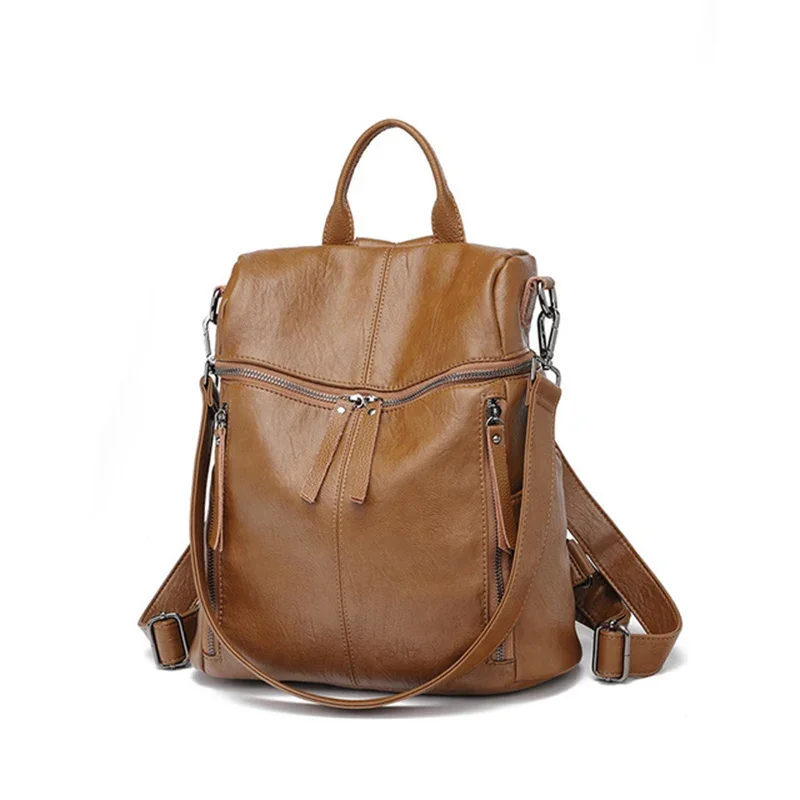
The “cost per use” calculation often favors quality leather despite higher upfront prices. A $300 bag used weekly for three years before deteriorating costs approximately $1.92 per use. In contrast, a $900 bag that lasts fifteen years costs only $1.15 per use—while providing superior functionality and aesthetics throughout its lifespan.
However, premium leather isn’t automatically worth the investment in every circumstance. Consider your specific needs:
- For seasonal or occasional-use bags, the longevity benefits may not justify premium pricing
- For rapidly changing style preferences, investment-quality leather might not align with desired flexibility
- For specialized applications with inherent wear expectations, moderately priced options might offer better value
Understanding the potential disadvantages of full-grain leather and other premium options helps make realistic assessments of when higher investment makes sense and when more modest options might serve better.
Common Questions About Leather Bag Quality
What leather type is best for everyday carry bags?
Full-grain and top-grain leathers typically offer the best balance of durability and appearance for daily use. Full-grain provides superior longevity and character development, while top-grain offers greater stain resistance with slightly less maintenance. For truly everyday use, either represents a solid investment, though full-grain generally performs better over extended periods.
How can I tell if a bag will develop an attractive patina?
Vegetable-tanned, minimally finished leathers develop the most pronounced patina. Look for terms like “natural finish,” “aniline,” or “pull-up leather” in descriptions. The ability to see natural variations in the leather surface typically indicates good patina potential. Heavily pigmented or finished leathers develop minimal patina regardless of quality.
What’s the difference between genuine leather and real leather?
All genuine leather is real leather, but not all real leather is what consumers might expect from “genuine leather.” Counterintuitively, “genuine leather” specifically refers to the third-grade tier below full-grain and top-grain. It’s made from lower hide layers with fiber structure partially compromised through processing. “Real leather” simply means derived from animal hide rather than synthetic materials, without specifying quality grade.
Are designer bags always better quality?
Not necessarily. While some luxury brands maintain exceptional standards, others rely more on brand recognition than material quality. Many designer bags use the same leather grades as mid-market options but command higher prices due to design, brand positioning, and exclusivity. Is full-grain leather better for backpacks than designer-branded alternatives? Often yes, when comparing purely on material quality rather than design elements.
Can damaged quality leather be repaired?
Most damage to quality leather can be repaired by skilled craftspeople. Scratches, scuffs, color fading, handle replacements, and even structural issues can typically be addressed in full-grain and top-grain leather goods. This repairability represents one of the significant value propositions of quality leather compared to synthetic alternatives or lower-grade leathers, which often cannot be meaningfully restored once damaged.
Conclusion: Making an Informed Leather Bag Choice
The journey through leather quality fundamentals equips you to make decisions based on substance rather than marketing. Understanding that leather quality encompasses grade, animal origin, tanning method, and finishing treatments provides a framework for evaluating any leather good with confidence.
Quality leather represents more than a purchase—it’s an investment in an item that evolves alongside you. The finest leather bags don’t merely survive use; they record it, developing unique characteristics that reflect your personal journey. This transformation process stands as perhaps the most compelling reason to choose superior leather.
As you apply this knowledge to future purchasing decisions, remember that true quality reveals itself over time. The initial impression matters, but the performance after years of use tells the complete story. By selecting wisely now, you choose not just a bag but a companion that improves rather than deteriorates with passing time.

